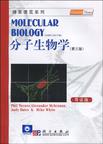分子生物学
出版时间:2009-8 出版社:科学出版社 作者:(英)特纳 等主编 页数:370
前言
转眼间,自从精要速览系列《分子生物学》第二版出版以来已有五年时间。在这短短五年里,分子生物学领域有许多值得关注的事件与发现。令我们印象深刻的是这本教科书不仅在英国本土,而且是在世界范围内,受到学生们的欢迎,已成为较为流行的课本之一。本书已被译成葡萄牙语、土耳其语、波兰语、法语、日语和中文等多种语言。正是因为如此,远到加德满都和伊斯坦布尔,近至我们自己的家园的热心读者都给我们发来了他们宝贵的意见和建议。我们非常感谢这些读者的宝贵意见,让我们听到了他们的声音,这有助于我们在第三版时进行改进。虽然本书只是对分子生物学的一个基本概述,但自第二版出版至今本学科已经发生了重大的进展。这些进展包括:整个小RNA分子领域,涉及microRNAs和RNA干扰技术,因此我们不得不更新了相关章节以求将这些新知识包含其中。另一重要的进展在于基因组学、蛋白组学、细胞成像和生物信息学方面,使我们意识到这些领域在未来将会产生重要且快速的突破,于是我们不得不在本书的最后,增加了两个章节来介绍上述这些快速发展的话题,如此处理会大大简化第三版修订与编排。在此特别感谢那些促成本书顺利出版的同仁,他们是Sarah Carlson,Liz Owen和Alison Nick,感谢他们的鼓励与耐心。更要谢谢我们的家人,因为图书编写占用了大量本应属于他们的时间,以至于我们无暇顾家庭时,他们也从不抱怨。最后衷心希望第三版能够继续帮助同学们学习、掌握分子生物学——生物学中一个非常有趣的学科领域。
内容概要
“精要速览系列(Instant Notes Series)”丛书是国外教材“Best Seller”榜的上榜教材。该系列结构新颖,视角独特;重点明确,脉络分明;图表简明清晰;英文自然易懂,被国内多所重点院校选用作为双语教材。 第三版在第二版基础上进行修订。对人类基因研究、RNA调控、组蛋白修饰、表观遗传学、人类进化等新近研究进行重点补充和调整,其他各章节也进行了修订。 本书适合普通高等院校生命科学、医学、农学等相关专业使用,也可作为双语教学参考教材使用。
书籍目录
第三版前言第二版前言第一版前言缩略词A 细胞与大分子 A1 细胞分类 A2 亚细胞器 A3 生物大分子 A4 大分子的组装B 蛋白质结构 B1 氨基酸 B2 蛋白质结构与功能 B3 蛋白质分析法C 核酸的性质 C1 核酸结构 C2 核酸的理化特性 C3 核酸的光谱学和热力学特性 CA DNA超螺旋D 原核与真核生物的染色体结构 D1 原核生物的染色体结构 D2 染色质结构 D3 真核生物的染色体结构 D4 基因组复杂度 D5 遗传信息流E DNA复制 E1 DNA复制概述 E2 细菌的DNA复制 E3 细胞周期 E4 真核生物的DNA复制F DNA损伤、修复与重组 F1 诱变 F2 DNA损伤 F3 DNA修复 F4 重组G 基因操作 G1 DNA克隆概述 G2 质粒DNA的制备 G3 限制酶与电泳 G4 连接、转化与重组体分析H 克隆载体 H1 质粒载体的设计 H2 噬菌体载体 H3 黏粒、YAC与BAC H4 真核生物载体I 基因文库与筛选 11 基因组文库 12 CDNA文库 13 筛选流程J 克隆DNA的分析与应用 J1 克隆的鉴定 J2 核酸测序 J3 聚合酶链反应 J4 克隆基因的组构 J5 克隆基因的诱变 J6 克隆技术的应用K 原核生物的转录 K1 转录的基本原则 K2 大肠杆菌RNA聚合酶 K3 大肠杆菌σ70启动子 K4 转录的起始、延伸与终止L 原核生物的转录调控 L1 乳糖操纵子 L2 色氨酸操纵子 L3 不同σ因子对转录的调节M 真核生物的转录 M1 三种RNA聚合酶:性质与功能 M2 RNA聚合酶Ⅰ基因:核糖体重复 M3 RNA聚合酶Ⅲ基因:5S基因与tRNA基因的转录 M4 RNA聚合酶Ⅱ基因:启动子与增强子 M5 通用转录因子与RNA聚合酶Ⅱ的起始N 真核生物的转录调控 N1 真核生物的转录因子 N2 转录调控举例O RNA加工与核糖核蛋白复合体 01 rRNA加工与核糖体 02 tRNA的加工、RNA酶P和核酶 03 mRNA加工、hnRNP和snRNP 04 可变mRNA加工P 遗传密码与tRNA ……Q 蛋白质合成R 噬菌体与真核生物病毒S 肿瘤病毒与癌基因T 功能基因组与新技术U 生物信息学进一步阅读的文献索引
章节摘录
The genome of viruses is defined by its state in the mature virion, and variesbetween virus families. Unlike the genomes of true organisms, the virus genomecan consist of DNA or RNA, which may be double- or single-stranded. In someviruses, the genome consists of a single molecule of nucleic acid, which maybe linear or circular, but in others it is segmented or diploid. Single-strandedviral genomes are described as positive sense (i.e. the same nucleotide sequenceas the mRNA), negative sense or ambi-sense (in which genes are encoded inboth senses, often overlapping; see Topic P1). Not all virions have a complete or functional genome, indeed the ratio of thenumber of virus particles in a virus preparation (as counted by electronmicroscopy) to the number of infectious particles (determined in cell culture)is usually greater than 100 and often many thousands. Genomes unable to repli-cate by themselves may be rescued during co-infection of a cell by the productsof replication-competent wild-type genomes of helper viruses, or of genomes with different mutations or deletions in a process known as complementation (see Topic H2). The replication/transcription strategies of viruses vary enormously from group to group, and depend largely on the type of genome. DNA viruses may make more use of the host cells nucleic acid polymerases than RNA viruses. DNA viruses with large genomes, such as herpesvirus (see Topic R3), are often more independent of host cell replication and transcription machinery than are viruses with small genomes, such as SV40, a papovavirus (see Topic R3). RNA viruses require RNA-dependent polymerases which are not present in the normal host cell and must, therefore, be encoded by the virus. Some RNA viruses such as the retroviruses encode a reverse transcriptase (an RNA-dependent DNA poly- merase) to replicate their RNA genome via a DNA intermediate (see Topic R4). The dependence of viruses on host cell functions for replication, and the requirements for specific cell-surface receptors determine host cell specificity. Cells capable of supplying the metabolic requirements of virus replication are said to be permissive to infection. Host cells which cannot provide the necessary requirements for virus replication are said to be nonpermissive. Under some circumstances, however, nonpermissive cells may be infected by viruses and the virus may have marked effects on the host cell such as cell transformation (see Topic R3 and Section S). Some viruses damage the cells in which they replicate, and if enough cells are damaged then the consequence is disease. It is important to realize that viruses do not exist in order to cause disease, but simply because they are able to repli- cate. In many circumstances, virulence (the capacity to cause disease) may be selectively disadvantageous (i.e. it may decrease the capacity for viral replica- tion) but in others it may aid transmission. The evolution of virulence often results from a trade-off between damaging the host and maximizing transmis- sion. The virulence mechanisms of viruses fall into six main categories: (i) Accidental damage to cellular metabolism (e.g. competition for enzymesand nucleotides, or growth factors essential for virus replication). (ii) Damage to the cell membrane during transmission between cells (e.g. celllysis by many bacteriophages or cell fusion by herpesviruses). (iii) Disease signs important for transmission between hosts (e.g. sneezingcaused by common cold viruses, behavioral changes by rabies virus).
编辑推荐
快速、准确掌握专业知识和专业外语的最佳套书!一种对教材概念的新的诠释! 精炼学科核心内容,以相对独立又互相关联的专题形式介绍各学科基础知识。 版式设计独特,方便学生快速、便捷地领会学科要点,便于复习与记忆。 编写风格统一,提供“结构化”学习方法。 世界范围内的主流教材——欧洲、北美等地众多高校广泛参考和使用, 国内数百家高校双语教学课程选用。 精要速览系列图书1999年面世至今受到广大读者的关注,2009年科学出版社隆重推如11个分册导读版的新版图书,2010年计划推出9个分册的中译版。其编写风格、取材角度仍继承前版特色,在内容上根据各学科发展进行修订和扩充。
图书封面
评论、评分、阅读与下载
用户评论 (总计15条)
- 我们分子生物学双语课用的是这本书,在网上找了很久在当当网上找到了。书不错,影印版的,看着发票心里很放心。很多同学也都准备在网上买这本书。
- 念大学的时候的教材,当时不觉得怎么样,还买了本中文版来对照着看
现在工作了到全E文的工作环境才发现这本书的价值
绝对值得买的书 - 不错的分子生物书
- 很实用的一本书,还可以锻炼英文阅读,一举两得!
- 老师要求买的书,据说是很好的内容。
- 中英文对照,内容偏简单
- 好!很值!
- 速度真的好快啊!而且书也很平整!
- 对于入门级很实用,而且有英语朗读CD
- 很好的,相当于总结,经典
- 买错了,本来要买中译本的
- Its price is reasonable, and contents are clear
- 拿到书后,有点失望,纸张不怎么样,而且听说有配套的英文朗读CD才买的,结果没有!想退货!
- 买错了一本书,没理由不退货阿,竟然直接拒绝了退货。什么嘛。太差劲了
- 里面是英文的,我以为是中文的,不过书应该还可以
